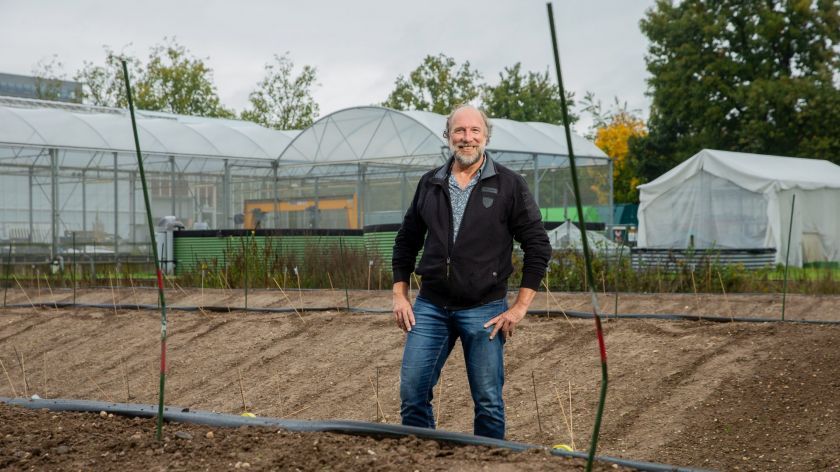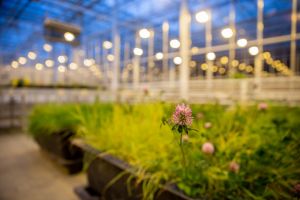-
 Eric Visser. Photo by David van Haren
Eric Visser. Photo by David van Haren
Four miniature dikes were recently installed on campus. Researchers from the Future Dikes project are using the test setup to investigate which plants best protect a dike from erosion.
Eric Visser leans forward and peers at the newly sown soil. It’s actually far too early to see the first seedlings peeping out above the earth, but the associate professor of Plant Ecology can’t resist. Earlier this month, he and his colleagues scattered seeds across four test dikes located between the greenhouses near the science faculty and the railroad tracks. The goal is to investigate which plants contribute most to the erosion resistance of a dike.
Plants makes a dike stronger, Visser explains. ‘Plant roots hold the upper layers of soil together and ensure that things don’t wash down when it rains. And that the dike doesn’t collapse during a flood.’ An important project since climate change and rising sea levels mean that many dikes need to be improved.
Root scanner
Visser and his colleagues are testing the effect of a diverse collection of plants, from wild carrots to clovers. They sowed twelve different herbs and six types of grasses, in ten different mixtures. No small task. ‘We want to test the mixtures more than once, so in total we had to sow eighty pieces of dike.’ The PhD student doing these experiments, Steven Huls, ended up calling in helpers to get it done in time. Even his mother came to help.

But the timing was right, Visser says. ‘We couldn’t have had better weather for sowing at this time. It will stay warm for a while longer, so in a few days we will already see the first sprouts coming out of the ground.’
Now they will have to wait for the roots of the plants, which the researchers want to study from the inside. ‘We have laid transparent tubes in two dikes where the roots can grow along. Using a scanner, we keep track of the growth.’ Different types of roots at different depths provide good erosion resistance, is the hypothesis.
Turfs
The test dikes on campus will remain in place for at least four years – that’s the time it takes plants on a dike to reach maturity. Researchers will use those years, among other things, to examine the effect of drought. ‘The summers of 2018 and 2019 were so dry that everything above ground died off. The levees were all brown. We want to know what the underground effect is.’
‘On the dikes around the Waal you can easily find ten species of bees that are very scarce’
The test dikes that do get enough water will look a lot brighter than the average dike in the Netherlands. A closed turf is usually the norm, Visser explains. ‘Herbs grow in tussocks and can leave holes in that turf. Water managers and dike administrators get nervous about that.’ Not necessary, thinks the plant ecologist. ‘We expect a diverse vegetation to be at least as strong as a turf, even if you are left with some open spots.’
An additional advantage is that a dike full of flowers and herbs attracts all sorts of insects. ‘You can see that around the Waal, where the dikes are already very diverse. You can easily find ten species of bees there that are very scarce in the Netherlands. Because we know that more than 70 percent of flying insects have disappeared, this is very important.’
Containers of water
The miniature dikes on campus are replicas of the dikes around the Waal, but three times smaller. ‘The slope is the same, as is the top layer and the bottom layer. We had the soil brought over from the dike reinforcement at Lent, because there were some leftover materials from the old dikes.’
‘We will put huge containers on the dike and let gigantic amounts of water flow over it’
A perfect replica, then, but to be on the safe side, Visser also does fieldwork on the larger version. ‘Together with colleagues, we go to dikes along the river Maas. There, we stab into the soil with a gouge to extract a column of clay. That way you can study the roots. We do this on dikes that are rich in species and on dikes with less biodiversity. Then in both places, we will pull the sods with sod pullers and measure how much force is needed to get them out of the ground.
It also includes the true test of strength – a flood. ‘We will put huge containers on the dike and let gigantic amounts of water flow over it, until the dike breaks.’ An experiment that requires caution, Visser knows. ‘But everyone realizes it’s necessary.’
Translated by Jan Scholten.



